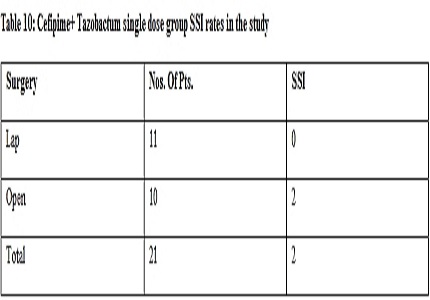A prospective study to find out the most cost effective preoperative prophylactic antibiotic regime in elective abdominal routine surgeries
Abstract
Introduction: Anti microbial prophylaxis before any elective surgery is a preferred deterrent to post operative surgical site infection now. A study was undertaken to evaluate the efficacy of preoperative prophylaxis in our hospital setting. We have used different antibiotics, two being from the cephalosporin class, one from the fluoroqiuinolones and anti beta lactamases in combination along with metronidazole. These were used in different combinations and for different durations. The aim was to find out the best and most economical pre operative prophylaxis in our surgical practice.
Methods: A total of 138 patients (above 16 years) were taken for the study. It was a randomized and blind study. Patients were prospectively analysed. First, the patients were divided into two groups, those who would receive a single dose of antibiotic at incision and those who received two more doses after the dose at incision. Next, the patients were analysed depending on operation room condition wise. The open elective as well as the laparoscopic elective procedures done in an OT condition where emergencies are undertaken as well as open and lap cases done in OTs where only elective cases are undertaken. The routine practice of preoperative bath, preoperative preparations of the area with iodophores and spirit, operating under normothermia and hydration were as per the institutional philosophy and common to all the patients. Cefotaxime+ Sulbactum, Ofloxacin + Metronidazole, Cefepime+ Tazobactum.
Result: Keeping the outcome of the study in mind all the materials was analysed and statistical analysis done and confidence intervals were noted. The single dose pre operative prophylaxis scored over three doses regime in all the cases for lap surgery irrespective of OT condition. Three doses regime worked better in combined OT condition for the open elective procedures. The study also revealed the most economic choice for routine elective abdominal surgery.
Conclusion: Multiday and antibiotics use for a prolonged period is not advisable these days after a routine elective abdominal surgery. Single dose injection of antibiotics at a proper time is good enough for preventing postoperative surgical site infection after a routine Laparoscopic surgery. Three doses regime is better in open surgical cases performed in OTs where emergency procedures are undertaken. It is advisable to use the most cost effective regime to reduce the healthcare cost in the country.
Downloads
References
2. Auerbach AD. Prevention of Surgical Site infection. Agency for healthcare Research and Quality 2001:221-44.
3. Nigel Mark Bagnall et al. Surgical site infection. Surgery, 1991;27(10):426-30.
4. Mangram AJ et al. Guideline for prevention of Surgical site infection, Infect Control Hosp Epidemiol 199;20:247-80.
5. Mandell GL et al, Douglas and Bennett’s Principles and practice of infectious diseases. 6th. EditionNew York:Elsevier/Churchill Livingstone, 2005.
6. Dellinger EP, Gross PA, Barrett TL et al. Quality standard for antimicrobial prophylaxis in surgical procedures. Infectious Diseases Society of America. Clin Infect Dis. 1994 Mar;18(3):422-7.
7. Page CP, Bohnen JM, Fletcher JR, McManus AT, Solomkin JS, Wittmann DH. Antimicrobial prophylaxis for surgical wounds. Guidelines for clinical care. Arch Surg. 1993 Jan;128(1):79-88.
8. Meijer WS, Schmitz PI, Jeekel J. Meta-analysis of randomized, controlled clinical trials of antibiotic prophylaxis in biliary tract surgery. Br J Surg. 1990 Mar;77(3):283-90. [PubMed]
9. DiPiro JT, Cheung RP, Bowden TA Jr, Mansberger JA. Single dose systemic antibiotic prophylaxis of surgical wound infections. Am J Surg. 1986 Nov;152(5):552-9. [PubMed]
10. Platell C, Hall JC. The prevention of wound infection in patients undergoing colorectal surgery. J Hosp Infect. 2001 Dec;49(4):233-8. [PubMed]
11. Dimick JB, Chen SL, Taheri PA, Henderson WG, Khuri SF, Campbell DA Jr. Hospital costs associated with surgical complications: a report from the private-sector National SurgicalQuality Improvement Program. J Am Coll Surg. 2004 Oct;199(4):531-7. [PubMed]
12. Kirkland KB, Briggs JP, Trivette SL, Wilkinson WE, Sexton DJ. The impact of surgical-site infections in the 1990s: attributable mortality, excess length of hospitalization, and extra costs. Infect Control Hosp Epidemiol. 1999 Nov;20(11):725-30.
13. Fiona Burton. Preventing surgical site infections. Wound essentials 2007;2:124-31.
14. Coello R et al. Adverse impact of surgical site infections in English hospitals. Journal of hospital infection 2005;60:93-103. [PubMed]
15. Kable AK, Gibberd RW, Spigelman AD. Adverse events in surgical patients in Australia. Int J Qual Health Care. 2002 Aug;14(4):269-76. [PubMed]
16. Rioux C, Grandbastien B, Astagneau P. The standardized incidence ratio as a reliable tool for surgical site infection surveillance. Infect Control Hosp Epidemiol. 2006 Aug;27(8):817-24. Epub 2006 Jul 24. [PubMed]
17. Nguyen D, MacLeod WB, Phung DC, Cong QT, Nguy VH, Van Nguyen H, Hamer DH. Incidence and predictors of surgical-site infections in Vietnam. Infect Control Hosp Epidemiol. 2001 Aug;22(8):485-92. [PubMed]
18. Moro ML, Morsillo F, Tangenti M, Mongardi M, Pirazzini MC, Ragni P; ICN Regional Group. Rates of surgical-site infection: an international comparison. Infect Control Hosp Epidemiol. 2005 May;26(5):442-8.



 OAI - Open Archives Initiative
OAI - Open Archives Initiative


